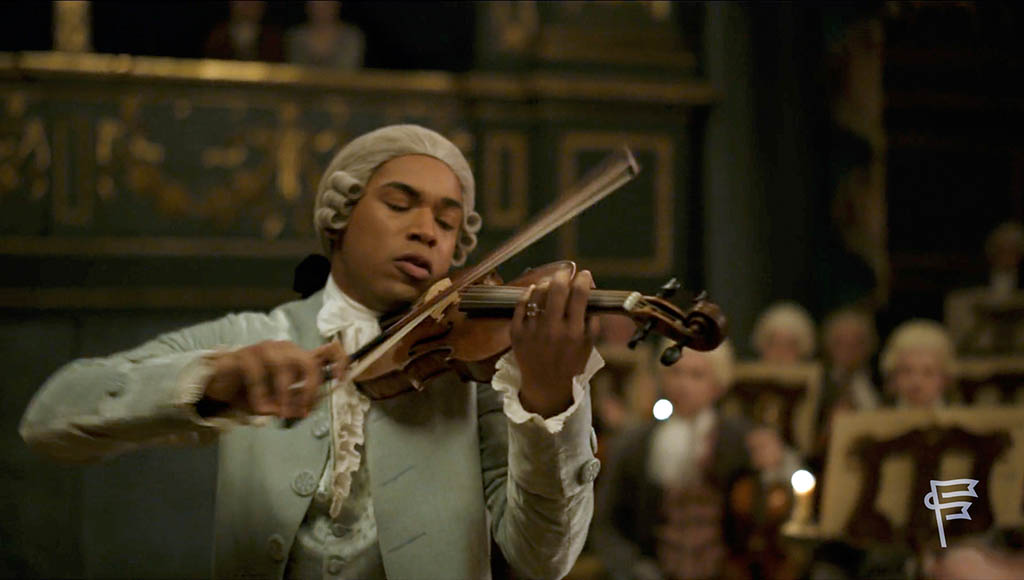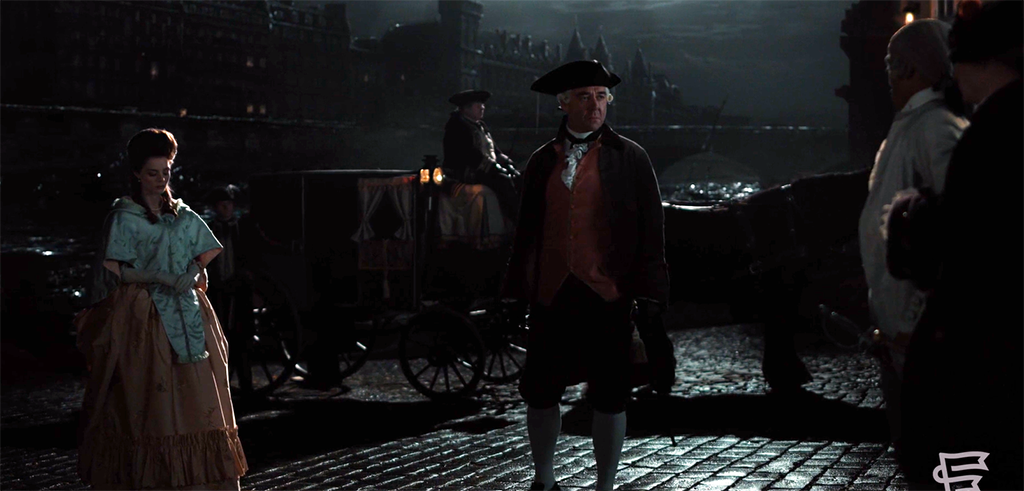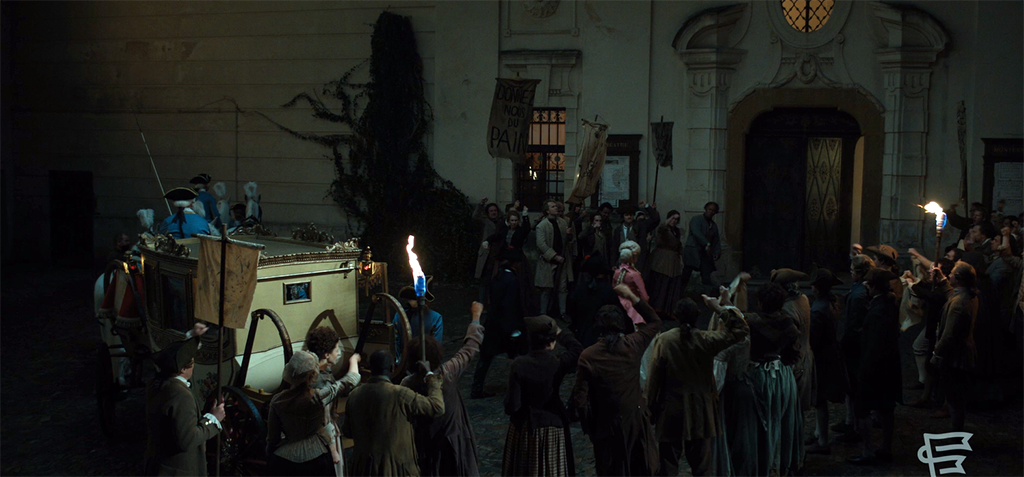By OLIVER WEBB
Images courtesy of Folks VFX.
By OLIVER WEBB
Images courtesy of Folks VFX.

Capturing the violin sequences proved to be one of the more complicated tasks for VFX Supervisor Simon Devault and his team.
Based on the dramatic true story of composer Joseph Bologne, Chevalier de Saint-Georges (portrayed by Kelvin Harrison Jr.), Chevalier depicts the tormented life of the renowned historical figure. Born to George de Bologne, a plantation owner, and a slave on Bologne’s plantation, Chevalier faces racial prejudice and harassment from his peers at a Parisian boarding school. Chevalier follows his ultimate rise to fame in French society as a celebrated violinist, composer and fencer, to his doomed love affair with Marie-Joséphine de Comarieu de Montalembert and complicated relationship with Marie Antoinette.

Folks VFX had to transpose the environment on the scene happening at the street level when Chevalier’s mother arrives at his apartment.
“The movie was shot in Prague, but Prague is not Paris. Our mission was to make sure it looked like Paris from around 1770. As an example, there are quite a lot of red roofs in Prague, but there aren’t any in Paris. We always had to remove them as soon as we saw any in the footage. … The production designer [Karen Murphy] had a reference book. She was sending us references from the time period that they wanted us to match. We needed to create something real from paintings references.”
—Simon Devault, VFX Supervisor, Folks VFX
Simon Devault served as VFX Supervisor on the film. “A little more than 10 years ago, I worked at another VFX facility where I met Philippe Thibault, who is one of the co-founders of Folks. Philippe left to start Folks and asked me if I wanted to join them. I was one of the few first employees at Folks, and I have been there for a little more than 10 years now. I grew within the company. I was a compositor at first, then Compositing Supervisor, then VFX Supervisor, and I’m now head of the studio. The company grew a lot over the years, and we now have offices in Toronto, Bogota and Saguenay. On top of that, we are a part of a group called Pitch Black that regroups other VFX companies such as RSP, El Ranchito and Fuse.”

Chevalier’s street was completely CGI.
Recalling his initial conversations with Chevalier director, Stephen Williams, Devault explains that Williams was the producing director on the first project Folks worked on. “Since the beginning, we have had a creative collaboration with Stephen,” Devault says. “He developed a good relationship with Sébastien Bergeron, the other co-founder of Folks who is now the CEO of Pitch Black. He often contacts us before the beginning of a project to help with the artistic direction of the show, creating look books, making fake trailers to set the mood, etc. This is the perfect example of what we like to do at Folks – be part of the process as early as possible. Storytelling is our business too. We have a great long-term relationship with Stephen.”
“The rooms were built on set in a studio with greenscreen in all the windows that we had to replace with Paris from around 1770. We also had to transpose that environment on the scene happening at the street level when his mother arrives at his apartment. Again, most of the environment around her was all VFX. CGI looks so clean, but Paris from 1770 was really dirty. A lot of the work went into dirtying up our CG environment to match that period. As an example, all the walls were stained by the smoke they had in the city coming from chimneys and fire pits.”
—Simon Devault, VFX Supervisor, Folks VFX

Folks VFX worked alongside Production Designer Karen Murphy.
Devault and his team worked in close collaboration with Production Designer Karen Murphy (The Great Gatsby, Elvis, A Star is Born) to make sure they were as historically accurate as possible with their depiction of Paris. “The movie was shot in Prague, but Prague is not Paris. Our mission was to make sure it looked like Paris from around 1770,” Devault says. “As an example, there are quite a lot of red roofs in Prague, but there aren’t any in Paris. We always had to remove them as soon as we saw any in the footage.” Creative references for Chevalier proved difficult to find for Devault and his team as they could only rely on paintings from the time period. “The production designer had a reference book. She was sending us references from the time period that they wanted us to match. We needed to create something real from paintings references.”
Everything seen from Chevalier’s apartment in the windows were CGI environments. “The rooms were built on set in a studio with greenscreen in all the windows that we had to replace with Paris from around 1770. We also had to transpose that environment on the scene happening at the street level, when his mother arrives at his apartment. Again, most of the environment around her was all VFX. CGI looks so clean, but Paris from 1770 was really dirty. A lot of the work went into dirtying up our CG environment to match that period. As an example, all the walls were stained by the smoke they had in the city coming from chimneys and fire pits,” Devault says.

A lot of the work went into dirtying up the CG environment to match Paris in the 1770s.
The film consists of numerous long shots which proved challenging to render for Devault and his team at Folks. “The timelapse scene of the Parisian street view from Chevalier’s window was particularly challenging,” Devault explains. ”We are at night in his apartment, we go to the window, we see the timelapse outside going from night to day and then go back into his apartment. The whole street was CGI. We really needed to recreate everything from scratch. All the people on the street were filmed and then added in later. That was a lot of work. There were also a lot of invisible transitions throughout the film, and we had to make them fluid and seamless. It was a lot of frame handling.”

The film consisted of around 250 visual effects shots in total.
Creating full CGI Paris was a major challenge for Devault; however, capturing the violin sequences proved to be one of the more complicated tasks. “The performance of the actor’s fingers when he was playing the violin was something as well. I am pretty sure nobody noticed that on the screen!” Devault says. “That was a good sign that it worked out well. Chevalier was the Jimi Hendrix of his time. We had to make Kelvin Harrison Jr. look like he is playing the violin like it and playing the right notes. Kelvin was able to play some basic violin, but we asked production to shoot an experienced violinist from different angles playing the same song. We then transposed the right fingering into Kelvin’s hands. So, the hand you see in the film is not his real hand in all of the shots. The compositor had to digitally remove his hand and then replace it with the new CGI one. That was the sort of invisible effect work that we had to do for the film.”

The rooms were built on set in a studio with greenscreen in all the windows.
“The timelapse scene of the Parisian street view from Chevalier’s window was particularly challenging, We are at night in his apartment, we go to the window, we see the timelapse outside going from night to day and then go back into his apartment. The whole street was CGI. We really needed to recreate everything from scratch. All the people on the street were filmed and then added in later. That was a lot of work. There were also a lot of invisible transitions throughout the film, and we had to make them fluid and seamless. It was a lot of frame handling.”
—Simon Devault, VFX Supervisor, Folks VFX

The team were used to doing crowd duplication as a result of the COVID-19 pandemic.
Discussing the revolution scenes, Devault notes that the team were used to doing crowd duplication due to the COVID-19 pandemic and the limitations it presented. “We all knew the drill,” he says. “For the revolution sequences, we had to add people into the background with the proper lighting and fire and everything. We rented some costumes and built some torches and filmed some actors in front of a greenscreen, and then we placed them in the scene. We shot a real group of people that we had to place afterwards, and it’s easier that way. In the theater during that scene, there wasn’t anyone on the balcony, so we had to add people there too.”


Actors were placed in front of a greenscreen in a studio and then planted into the revolution scenes. Devault and his team relied on paintings from the time period for reference.
Devault and his team also worked on the fencing sequence where Chevalier impresses Marie Antoinette with his fighting skills. Despite having few visual effects, the scene was time-consuming, and Devault and his team worked round the clock to deliver. “During the fight you see blood, but on the plate there was nothing, and we had to add the wounds afterwards. All the blood on his shirt was added in.We needed to make it work for the fight. It was subtle, but it took time to get there and track it properly,” Devault says.

The red roofs of Prague needed to be adjusted for the Parisian landscapes.
“The performance of the actor’s fingers when he was playing the violin was something as well. I am pretty sure nobody noticed that on the screen! That was a good sign that it worked out well. Chevalier was the Jimi Hendrix of his time. We had to make Kelvin Harrison Jr. look like he is playing the violin like it and playing the right notes. Kelvin was able to play some basic violin, but we asked production to shoot an experienced violinist from different angles playing the same song. We then transposed the right fingering into Kelvin’s hands. So, the hand you see in the film is not his real hand in all of the shots. The compositor had to digitally remove his hand and then replace it with the new CGI one. That was the sort of invisible effect work that we had to do for the film.”
—Simon Devault, VFX Supervisor, Folks VFX

Creating full CGI Paris was one of the many challenges for Devault.
The film consisted of around 250 visual effects shots in total, with Folks serving as the main vendor on the film. “As we always do, we tried to find the most convincing and effective way to tell the story and produce the best images possible within the constraint of the project. I am very glad to have been a part of the production on that historical film. I love when a movie paints the injustice and mistakes of our society in the past, makes people think about where we are at now, then shape a better future,” Devault concludes.

Kelvin Harrison Jr. as Chevalier standing against greenscreen in the studio apartment set with greenscreen in all the windows.
Click here to watch Folks VFX’s video breakdown of key VFX scenes from Chevalier. https://folksvfx.com/our-work/filmography/22991/